Cryptocurrency news website CoinDesk reported that Tether’s CEO, Paolo Ardoino, revealed that the company holds over 82,000 bitcoins and 48 tons of gold reserves. Ardoino disclosed this on X, while also clarifying comments about Tether USDT reserves.
This was in response to earlier statements made during the Lugano B event. He explained that the company also holds over $100 billion in US Treasury bonds to support the USDT stablecoin. Therefore, all USDT is fully backed.
He said, “As I’ve seen a lot of confusion in this thread, let me clarify: Tether has around $100 billion in US Treasury. Additionally, it has 82,000 bitcoins and 48 tons of gold.”
Ardoino’s comments received positive feedback from the cryptocurrency community, with some noting the diversification of Tether’s reserves. Some observed that Tether’s gold-backed USDT is very good, meaning USDT has gold backing. They consider this even better than the actual US dollar that stopped being backed by gold in the 1970s.
Meanwhile, other users were more interested in the full status of Tether’s reserves, especially how the gold is stored and whether it has been audited. One user on X questioned whether the gold in Tether’s reserves is actual gold bars or derivatives such as exchange-traded funds (ETFs) and options.
The public disclosure of how Tether supports its USDT stablecoin seems to be in response to recent claims by The Wall Street Journal that the company is under investigation by the US Department of Justice. Although Tether immediately denied this, calling it pure speculation and “repeating old noise,” it was enough to cause a market reaction.
Ardoino subsequently attempted to calm fears, uncertainties, and doubts (FUD) by pointing out that Tether is working with global law enforcement agencies, including the United States, to combat crime. Therefore, the company would receive information about any investigation into it.
He said, “We will know if we are under investigation as per the article. Based on that, we can confirm that the allegations in the article are without any doubt.”
This is not the first time that the stability of USDT has been questioned, and each time it has attracted wider market attention. USDT holds a significant position in the cryptocurrency market, with a market capitalization of $120 billion and is used for most cryptocurrency trades. According to CoinMarketCap data, USDT had a trading volume of $32 billion in the past 24 hours, surpassing any other cryptocurrency asset, highlighting its importance in the cryptocurrency ecosystem.
This importance means that any news questioning the stability of USDT will have a negative impact on the market. However, the market seems to have recovered from the FUD that followed the news. Data from CoinGlass shows that the value of Bitcoin has slightly increased, and the total open interest of cryptocurrency products has increased by over 1%. Nevertheless, futures trading volume has decreased by 43% in the past 24 hours.
Meanwhile, Tether continues to gradually diversify, expanding its business beyond stablecoin issuance. The company recently previewed its Local AI development toolkit, which is used to write and deploy artificial intelligence systems on various devices.
Ardoino, who launched the product, claimed that it focuses on privacy and enables developers to write code on all devices, from mobile phones to high-end computing systems powered by H100 chips, using peer-to-peer technology. According to Ardoino, the SDK supports various AI models, including Llama and Marian, making it suitable for various purposes.
Ardoino said, “Tether’s AI SDK is highly modular, it supports any model (Marian, Llama, etc.) and loads/stores weights and fine-tuning data in a P2P data structure.”
The Tether AI SDK has not been released yet, but as Ardoino pointed out, once the company has thoroughly tested it and deemed it ready for public release, it will be open source.

